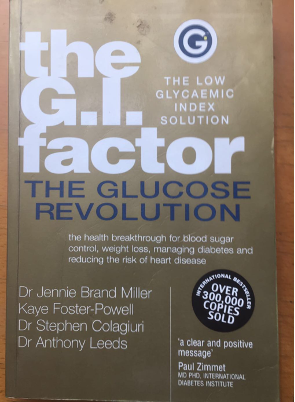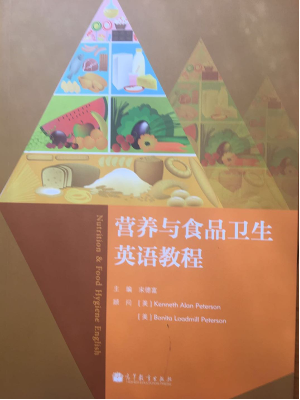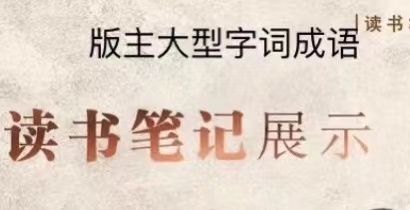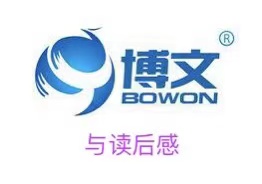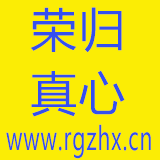In Section Forty-three “Fracture Suffering Seeming No End; Writing Benefitting Bone Recovering”, there is a description of my feeling when I got to know that I had got diabetes before the operation on the neck of my thigh bone in 2001: “However a lot of things worried me in my mind. Before the operation I was checked normally and discovered my blood glucose with the empty stomach reached 9mmol/L. The doctor said that I suffered from the diabetes. I had zero knowledge of the blood glucose and I was at a loss, the complication caused by the diabetes being terrible for me.” And in Section Forty-nine “Great Ambition Arose during One Year’s Stay in Australia; Practice in China meeting with a lot of difficulties” it is mentioned that I bought a book in English about how to control one’s glucose level: “One day, Li Song brought us to a used market run by a church, where a lot of things were contributed and sold to finance the church. I found a book, seeming not to have been read by anybody. The author finished writing it in 1998, and was published in 2000. Its cover said it was about how to control one’s blood sugar and one’s weight and how to protect one’s heart in an effective way, which I was taking care of. It cost me only two dollars and I began to read it carefully. Although it was about the medical and nutritional subject I read it and could understand its essentials. I had another dream of whether I could edit a nutritional English course.”
It was a very long span from beginning to have a dream to its turning into reality. In 2006 I bought the book---the G.I. Factor---the glucose revolution and I got to know the sample book “Nutrition and Food Hygiene English Course” edited by me came to my home at Xuzhou in Feb. 2012. It was the whole six years. How you can imagine it!
|
|
| The first author is Jennie Brand Miller , who holds a chair in human nutrition in the School of Life and Environmental Sciences at the University of Sydney. 2018: Elected Fellow of the Australian Academy of Science | I planned in 2006 and the course book of “Nutrition & Food Hygiene English”was finally published in Higher Education Press in 2012, lasting |
In 2006 and 2007, I did not know what kind of editorial room of the High-education Press was willing to publish such a subject. An editor of the publishing house of Beijing University of Technology dropped a letter into my email-box. Since the house was active in promoting its ad, I would have a try and asked whether it was willing to accept this subject. It did not know what kind of colleges would use such a course. I got touch with an editor of the HEP in charge of medical courses, who had no interest in it at all. Later I contacted the editor of life science and sent the application form to her, who did not refuse and asked me to pay ¥40,000 to publish network version, which made me very disappointed. I had never paid to appear an article or to publish a book, and could get some reward instead. The attitude of the editor made me have such a feeling that I had found the correct door. The next task was to persuade her to publish the book.
I decided to solve the problem of what kind of colleges and universities had the specialty of nutrition by investigating. First I searched in the schools having the food specialty, discovering few of them had the nutrition department. Some vocational institute had students who majored in cook and also study some nutrition, but they would not study the nutrition English. Only those who study in the undergraduate level would study the professional English. By searching and browsing online for days I found that almost all the medical colleges or universities had nutrition specialty, which belong to the school of the public health. I worked hard and collected the names of the heads of the teaching & research group (TRG) of nutrition and food hygiene and their communication means as well, which I sent to the editor, Li Wang. I wrote a letter to the heads of the TRG and asked them to download a form I had designed to fill in, telling us about whether the professional nutrition English was taught or not in their school. The letter also asked them whether they would participate in writing the book if the HEP decided to publish the English book. Because online tricksters were too many, I asked Li Wang to send traditional letters, ie snail letters, to the heads of the TRG. At the bottom of the letter was pressed the seal of the HEP.
Ms Li Wang promised me to do as I suggested, however what she did was very slow. From the end of April to that of August of 2010 we were in America. During that period, I phoned her several times, which made me shameful. In the end, she finished sending the investigation letters to heads of teaching and research teams of the designated schools.
The investigation forms returned to Wang’s email box and then were transferred to mine by her. We received 8 forms, which seemed to make her somewhat interested in the subject. I wrote a letter in the name of the editing office of Life Science of the HEP, telling everyone that the HEP decided to compile an English course on nutrition and food hygiene. I also wrote a compiling plan, which was attached to the letter. I selected 10 of the teachers from the feedback and began to write the book.
I divided what had been collected from online into three parts. The first part was macronutrients, including the basics of carbohydrates, fats and proteins. The second part was made of major micronutrients, which were vitamins, minerals, as well as dietary fiber and metabolism. The third part began with food pyramid, making reference to special nutrition for special groups of people, food hygiene and some knowledge of phytochemicals and biochemical and molecular nutrition. I designed the sample script according to the professional English courses I had compiled before and sent the material I had collected to the coauthors, letting them to write according to the sample. Because all of them had not done such a job before, what they did was not satisfying. I rewrote it and painted different colors on what they had written, pointing out why it was inappropriate. By working four months plus, I finally finished writing the whole book, packed what had been written and sent to Ms Wang, the editor in charge.
The consideration of the script lasted very long time. In Oct. of 2011, the publishing agreement was signed, promising only 6% royalty on each copy. The co-authors asked me about the time when the book could come into exist. I could not give them the exact time until Dec of 2011. The editor wrote to me, saying that the book was sure to be published in Jan. of 2012. In Feb, the sample books were sent to all the authors when I was in America, where I got a sum of money in my credit card, which I thought to be loyalty of “Sign English” published in the CWPH (China Water Publishing House). At the end of April I got home in Xuzhou and saw the sample book of Nutrition and Food Hygiene and got to know as well that the sum of money, ¥3800 was its royalty. I kept promise and sent contribution fee to every one of the 9 co-authors by online bank. Ms Ling Wang from Zhengzhou Medical University told me that she had participated in compiling eight books and only this one gave her some contribution fee. ¥2000 was left for myself, which was not much, but I was delighted that the book was published in the end and I had learned a lot about the nutrition. Our diet custom has changed fundamentally, the effect of controlling the glucose is obvious. In fact, my glucose level belongs to the prophase of the diabetes I should pay enough attention to, which is called “prevention first”. Thanks to the knowledge of dietetics, terror feeling disappears from my mind. I didn’t give weight to the benefit of money. Furthermore, if it sold well, I could get more, otherwise it would seem like the book of Electronic Business English, whose royalty seldom came.
Finished on May 28 of 2012 in Xuzhou
Revised on Oct. 10 of 2018 in Xuzhou
Proofreading on Jan 3 2019 in Fenghuayuan
Uploading on Aug. 9 of 2023 in Xuzhou


